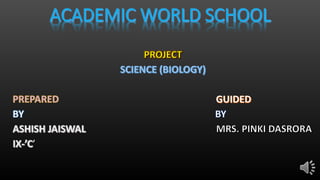
Classification of matter
- 1. ’
- 2. Anything which has mass and occupies space is known as matter. Matter can be identified or felt with our senses. For example, we cannot see air but we can feel it. Our eyes can see the physical state of matter, their physical changes and recognize them as solid, liquid or gas. However, we can feel heat, light, electricity, attractions emotions, beauty, sorrow, thoughts and ideas also but the ar e not considered as matter because they do not acquire any space and do not acquire any space and do not have mass.
- 3. Modern day scientists have classified matter on the basis of physical and chemical properties. Physical classification Solid Liquid Gas Plasma BEC Chemical classification Element Compound Mixture
- 4. Factor deciding the states of matter. 1. Temperature: As temperature increase, the kinetic energy of the particles increases and solid matter may change into liquid and liquid may change to gaseous state. 2. Pressure: Change in pressure can change the state of matter. 3. Interparticle space: States of matter also depend upon interparticle space. 4. The force of attraction among the particles: We have learnt that every matter is made up of particles which may be atoms, molecules or ions. These particles are held together through a force which is called interparticle force.
- 5. Solids can be defined as the state of matter in which the particles are closely packed. One of the important features of solids under normal conditions is that they resist change in their shape due to strong interparicle force of attraction. Since the particles of solid are tightly held by strong force they can vibrate only at their position. This vibration becomes faster on heating. To change the closely packed arrangement or to melt the solid, very high temperature is required. Thus, melting point of solid is high.
- 6. The properties of solids are as follows: 1. Definite shape and volume: Solids have definite shape and volume. 2. Ability to form lattice: Crystalline solids have well defined lattice. Lattice is an arrangement of particles in a specific order. 3. Little cubical expansion: Solids show very little Cubical expansion or thermal expansion as compared to liquids and gases. 4. High rigidity: The solids are generally rigid in nature and cannot change their shape. 5. Low compressibility: Solids can not be compressed under normal conditions. 6. Negligible kinetic energy: The particles of solids have negligible kinetic energy because particles need space to move which is absent in solids. 7. Less or no diffusion: Solids generally do not show diffusion because their particles have very less kinetic energy.
- 7. LIQUID STATE Liquid refers to those substances which show fluidity or which can flow but are almost incompressible and have a definite volume. The particles in a liquid are somewhat loosely packed and the space between the particles is slightly more than that in solids. As liquids do not have higher kinetic energy as compared to solids.
- 8. The properties of liquid are as follows: 1. No fixed shape: The liquid do not have fixed shape. They take the shape of the container in which they are stored. 2. Fixed volume: The liquids have fixed volume because at given temperature the interparticle space of liquid is fixed. 3. Fluidity: Liquids show fluidity. It means they can flow from height to depth or from high pressure to low pressure. 4. Density: The liquids have lesser density than solids but have high density as compared to gases. 5. Kinetic energy: The particles of liquids have high kinetic energy as compared to solids. 6. Diffusion: The rate of diffusion in liquids is faster as compared to solids.
- 9. The state of matter having loosely arranged particles, highest volatility and negligible force of attraction between the particles is called gas.
- 10. The properties of gases are as follows: 1. No definite shape: The gases do not have fixed shape as the particles are very far apart because of negligible force of attraction. 2. No fixed volume: Gases do not have fixed volume because the particles have high kinetic energy and can move in all directions. 3. Highly compressible: Gases are highly compressible because the particles are far apart under normal conditions. 4. Thermal expansion: The gases show high thermal expansion because of very weak interparticle force of attraction in gases. 5. Low density: The density of gases is very low. The particles of gases are very far apart. 6. Rigidity and fluidity: Intermolecular attraction is least in gases because of large intermolecular spaces. 7. Diffusion: In gases, rate of diffusion is very high as their particles have high kinetic energy.
- 11. Plasma is the fourth state of matter. At a very high temperature, we can observe the fourth state of matter called plasma. It is composed of free electrons and ions. This state of matter has very low density.
- 12. At an ultra-low temperature of about nano Kelvin that is almost equal to zero Kelvin; there exist fifth state of matter which is called BEC. In this state, the whole matter behaves as a single component or atom because the kinetic energy of the atoms becomes so low that there is hardly any vibration shown by atoms. This is also called gaseous super fluid.